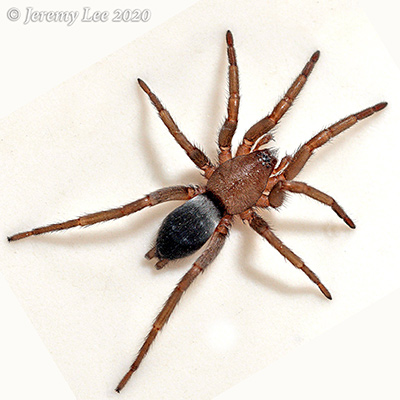
 |
|
Scientific Classifications explained » Amphibians » Ants » Aphids » Bees » Beetles » Birds » Bugs » Butterflies » Caterpillars » Damselflies » Dragonflies » Earwigs » Flies » Frog/Leafhoppers » Fungi » Galls » Grasshoppers » Harvestmen » Hoverflies » Lacewings » Ladybirds » Leaf Mines » Lichens » Mammals » Millipedes » Mosses » Moths » Sawflies » Slugs » Snails » Spiders » Trees & Shrubs » Wasps » Wild Flowers » Woodlice » Postboxes |
UK Nature > Spiders > Scotophaeus blackwalli

Scientific Name: Scotophaeus blackwalli Common Name: Mouse Spider Scotophaeus blackwalli, also known as the Mouse Spider, is a species of spider belonging to the family Gnaphosidae. This species is widespread throughout the UK except northern Scotland. They are commonly found around and inside houses, usually in the autumn, and also under bark and in holes in walls. Mouse spiders are are mostly nocturnal and very fast runners. They catch their prey by stalking, and then pouncing on unsuspecting invertebrates. The adult males of these spiders reach 9mm in length, maturing in the early summer, while females reach 12mm, and can be found until autumn. The carapace is dark brown while the abdomen is brown/grey with hairs resembling the body of a mouse, hence the common name. The legs are brown and relatively quite thick. The male has a small scutum on the dorsum of the abdomen. |
|

https://www.uknature.co.uk is a website dedicated to showing the immense diversity of UK nature and wildlife. Our vast range of habitats, from lowland arable to snow covered mountains, from storm-ravaged coastlines to peaceful inland freshwater lakes and rivers, from dry, sandy heaths to deciduous and coniferous forests, all these habitats contribute to the abundance of UK nature. We have wild birds in huge numbers either residing or visiting our shores (597 recorded species as at July 2013) and we must also not forget the humble back garden with its grass lawns, flower beds filled with nectar rich flowers, shrubs and trees, all designed to attract huge numbers of insects such as bees, moths, butterflies and hoverflies; and finally the small ponds which provide safe havens for frogs, toads, newts and even slow worms and grass snakes. www.uknature.co.uk is the showcase for my personal passion, photographing uknature in all its glory. I sincerely hope you all enjoy the fruits of my labours. This site and all images contained therein is © Jeremy Lee 2004 - 2025. All Rights Reserved. Site design by Jeremy Lee. Site development & IT Support by Stuart Lee. |